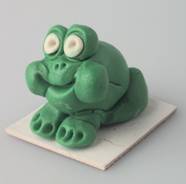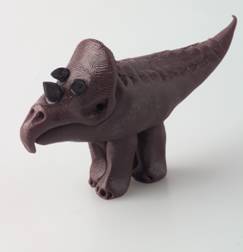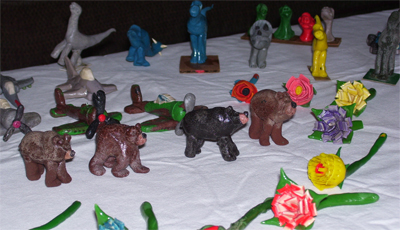Children and Play Therapy

CLAYtherapy is a new and exciting way to incorporate counseling and play, into what is called play while-we-talk therapy.
Going to counseling for most children, preschool to high school is an experience outside their normal routine. They are asked to talk to an adult they have never met, then dialogue about things they can hardly articulate. We anticipate they will grasp life concepts, understand social situations, uncover sleeping giants, and then sculpt lasting solutions. They are asked to engage in and trust a process called "therapy". Therapy is difficult enough for adults clients, sometimes even the counselor, to pull-off, and then to do that behind closed doors with a few toys for the better of an hour. (Where else do they talk with an adult, one-on-one for an hour?)
Most children have had few significant adult relationships to reflect upon beyond family and school, yet they are asked to talk with us about cognitive abstractions and to resolve life dilemmas that confound most adults. They are expected to grasp complex human relationships, how and why adults divorce, why bullies harass; further why compulsions exist, self-harm looms, depression descends, anxiety consumes and nightmares rob them of sleep. Counseling is indeed a complex process for them.

Play therapists communicate with children through the medium of toys; blocks, dolls, puppets, paints, vehicles and, of course, modeling clay. Children are naturally attracted to clay. Most have grown up with modeling clay at home and school. Children like clay. If children don't have clay they will play with pie dough, mud, pudding, ice cream or mashed potatoes. They like feeling, molding, squishing, rolling and pounding clay. Counselors use clay because it helps children explore and express fundamental emotions. CLAYtherapy relieves a child's fears of counseling, grabs and holds their interest, provides a wide array of clinical connections and establishes an immediate problem-solving environment. Children are drawn to its visual appeal and hands-on attraction. Its play-while-we-talk, something-to-take-home when we are finished approach, is the ultimate intake icebreaker while the depth of its clinical application is limited only by the counselor's creativity, clinical insight and experience.
However, when done right the process magically works. I think children usually know before they arrive in my lobby that something is not right in their life. They just have difficulty acknowledging life in spite of it. Most will accept help when engaged properly and respectfully.
The resulting therapeutic relationship provides them a conduit for expression and an environment of discovery. They will usually make comments later like, "At first I didn't want to go to counseling but now it's not so bad." Or "When can I go back to counseling?"
Play therapists communicate with children through the medium of toys; blocks, dolls, puppets, paints, vehicles and, of course, modeling clay. Children are naturally attracted to clay. Most have grown up with modeling clay at home and school. Children like clay. If children don't have clay they will play with pie dough, mud, pudding, ice cream or mashed potatoes. They like feeling, molding, squishing, rolling and pounding clay. Counselors use clay because it helps children explore and express fundamental emotions.

 CLAYtherapy is a new and exciting way to incorporate counseling and play, into what is called play while-we-talk therapy.
Going to counseling for most children, preschool to high school is an experience outside their normal routine. They are asked to talk to an adult they have never met, then dialogue about things they can hardly articulate. We anticipate they will grasp life concepts, understand social situations, uncover sleeping giants, and then sculpt lasting solutions. They are asked to engage in and trust a process called "therapy". Therapy is difficult enough for adults clients, sometimes even the counselor, to pull-off, and then to do that behind closed doors with a few toys for the better of an hour. (Where else do they talk with an adult, one-on-one for an hour?)
Most children have had few significant adult relationships to reflect upon beyond family and school, yet they are asked to talk with us about cognitive abstractions and to resolve life dilemmas that confound most adults. They are expected to grasp complex human relationships, how and why adults divorce, why bullies harass; further why compulsions exist, self-harm looms, depression descends, anxiety consumes and nightmares rob them of sleep. Counseling is indeed a complex process for them.
CLAYtherapy is a new and exciting way to incorporate counseling and play, into what is called play while-we-talk therapy.
Going to counseling for most children, preschool to high school is an experience outside their normal routine. They are asked to talk to an adult they have never met, then dialogue about things they can hardly articulate. We anticipate they will grasp life concepts, understand social situations, uncover sleeping giants, and then sculpt lasting solutions. They are asked to engage in and trust a process called "therapy". Therapy is difficult enough for adults clients, sometimes even the counselor, to pull-off, and then to do that behind closed doors with a few toys for the better of an hour. (Where else do they talk with an adult, one-on-one for an hour?)
Most children have had few significant adult relationships to reflect upon beyond family and school, yet they are asked to talk with us about cognitive abstractions and to resolve life dilemmas that confound most adults. They are expected to grasp complex human relationships, how and why adults divorce, why bullies harass; further why compulsions exist, self-harm looms, depression descends, anxiety consumes and nightmares rob them of sleep. Counseling is indeed a complex process for them.
 Play therapists communicate with children through the medium of toys; blocks, dolls, puppets, paints, vehicles and, of course, modeling clay. Children are naturally attracted to clay. Most have grown up with modeling clay at home and school. Children like clay. If children don't have clay they will play with pie dough, mud, pudding, ice cream or mashed potatoes. They like feeling, molding, squishing, rolling and pounding clay. Counselors use clay because it helps children explore and express fundamental emotions. CLAYtherapy relieves a child's fears of counseling, grabs and holds their interest, provides a wide array of clinical connections and establishes an immediate problem-solving environment. Children are drawn to its visual appeal and hands-on attraction. Its play-while-we-talk, something-to-take-home when we are finished approach, is the ultimate intake icebreaker while the depth of its clinical application is limited only by the counselor's creativity, clinical insight and experience.
However, when done right the process magically works. I think children usually know before they arrive in my lobby that something is not right in their life. They just have difficulty acknowledging life in spite of it. Most will accept help when engaged properly and respectfully.
The resulting therapeutic relationship provides them a conduit for expression and an environment of discovery. They will usually make comments later like, "At first I didn't want to go to counseling but now it's not so bad." Or "When can I go back to counseling?"
Play therapists communicate with children through the medium of toys; blocks, dolls, puppets, paints, vehicles and, of course, modeling clay. Children are naturally attracted to clay. Most have grown up with modeling clay at home and school. Children like clay. If children don't have clay they will play with pie dough, mud, pudding, ice cream or mashed potatoes. They like feeling, molding, squishing, rolling and pounding clay. Counselors use clay because it helps children explore and express fundamental emotions.
Play therapists communicate with children through the medium of toys; blocks, dolls, puppets, paints, vehicles and, of course, modeling clay. Children are naturally attracted to clay. Most have grown up with modeling clay at home and school. Children like clay. If children don't have clay they will play with pie dough, mud, pudding, ice cream or mashed potatoes. They like feeling, molding, squishing, rolling and pounding clay. Counselors use clay because it helps children explore and express fundamental emotions. CLAYtherapy relieves a child's fears of counseling, grabs and holds their interest, provides a wide array of clinical connections and establishes an immediate problem-solving environment. Children are drawn to its visual appeal and hands-on attraction. Its play-while-we-talk, something-to-take-home when we are finished approach, is the ultimate intake icebreaker while the depth of its clinical application is limited only by the counselor's creativity, clinical insight and experience.
However, when done right the process magically works. I think children usually know before they arrive in my lobby that something is not right in their life. They just have difficulty acknowledging life in spite of it. Most will accept help when engaged properly and respectfully.
The resulting therapeutic relationship provides them a conduit for expression and an environment of discovery. They will usually make comments later like, "At first I didn't want to go to counseling but now it's not so bad." Or "When can I go back to counseling?"
Play therapists communicate with children through the medium of toys; blocks, dolls, puppets, paints, vehicles and, of course, modeling clay. Children are naturally attracted to clay. Most have grown up with modeling clay at home and school. Children like clay. If children don't have clay they will play with pie dough, mud, pudding, ice cream or mashed potatoes. They like feeling, molding, squishing, rolling and pounding clay. Counselors use clay because it helps children explore and express fundamental emotions.
